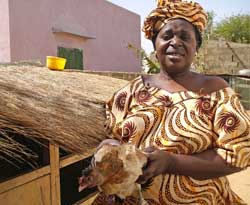Disease modeling effort expands
April 2010 | Volume 9, Issue 2

Photo courtesy USAID
Scientists are using mathematical modeling
to better understand how diseases travel
between humans and animals.
By David Taylor
A group of scientists applying mathematical models to better understand the progression of infectious disease outbreaks has published recent findings on rotavirus and influenza transmission patterns and an analysis of how diseases travel between humans and animals.
Since mid-2008, the team has been working together as part of the
Research and Policy for Infectious Disease Dynamics program - known as RAPIDD - with the goal of making modeling more relevant for policy makers responding to infectious disease outbreaks.
While mathematical and computational modeling of infectious diseases is a vibrant and rapidly growing field, it's still a very new concept in many areas of public and veterinary health.
"The idea of RAPIDD is to improve standards in infectious disease modeling" to better inform policy, says Dr. Ellis McKenzie, Fogarty senior scientist. Managed by McKenzie and his academic counterpart Dr. Bryan Grenfell, a population biologist at Princeton University, the program has grown to involve about 50 scientists focused on topics including model hierarchies, zoonotic infections and vector-transmitted diseases.
Three recent papers in
Science underscore the initiative's broad view of the field. One effort, which included input from Fogarty director Dr. Roger I. Glass, examined rotavirus. The study used modeling to show that apparent waves of rotavirus moving from east to west across the U.S. were probably due to patterns in birth rates, since the number controls how many susceptible infants fuel the epidemic. The research team showed that the model, using parameters of pre-vaccination dynamics, closely resembled the decline and lag in rotavirus epidemics seen in the vaccine era.
"In terms of RAPIDD's aims, this is an unusual example of 'out-of-sample' model validation," Grenfell says of the paper.
Another analysis, titled "Epidemic Dynamics at the Human-Animal Interface," was produced by a team led by Dr. James Lloyd-Smith of the University of California at Los Angeles. It outlined gaps in disease modeling efforts and detailed the need for new models.
"Models incorporating spillover transmission - the defining process of zoonotic dynamics - are dismayingly rare," the authors observed. Likewise, models rarely consider the "stuttering chains of transmission" by which minor outbreaks occur and die out as a disease moves from an animal host to humans. Stage III zoonoses, such as monkey pox, Nipah virus or H5N1 avian flu, are the best-identified threats for future pandemics among humans, and their dynamics should receive priority attention from modelers, the article urged.
A third paper examined the impact of immune escape on influenza transmission by using equine data combined with epidemiological models. Lead author Dr. Andrew Park, of the University of Georgia, and his colleagues concluded the synthesis of disease data illustrated how herd immunity and immune escape are related and the ultimate goal is to link these results to epidemic dynamics. Their ideas could extend to a broad class of infectious diseases, they suggest.
Funded by the Department of Homeland Security through the White House National Science and Technology Council, the RAPIDD initiative offers what McKenzie calls a good example of dual use results. Models for responses to bioterrorist attacks, for example, can often be useful against natural epidemics, and vice versa.
Grenfell agrees. "Many vector-transmitted infections are particularly underserved mathematically," he says, "and a new RAPIDD working group on mosquito-transmitted infections is now addressing this gap." He adds that exploring how models can more directly tackle issues related to policy decisions could be an exciting direction in the future.
More Information
To view Adobe PDF files,
download current, free accessible plug-ins from Adobe's website.